Index

Preview: True flagship performance
Today we will have a brief look at Corsair’s Neutron GTX 240GB Solid State Drive.
Corsair introduced SSD drives based on the new Link A Media Devices controller at Computex last year, just a tad before Link a Media Devices, aka LAMD, was acquired by Hynix. Corsair is the first outfit to bring an SSD based on the latest LAMD controller to the market.
The LM87800 controller features an 8-channel architecture that incorporates extensive hardware acceleration, dedicated host-side and NAND-side ARM microcontrollers, and a 6Gbps SATA host interface.
This SSDs series consist of three models in 120GB, 240GB and 480GB capacities. Neutron GTX series are now Corsair’s flagship consumer performance models, displacing Force GS series units from pole position.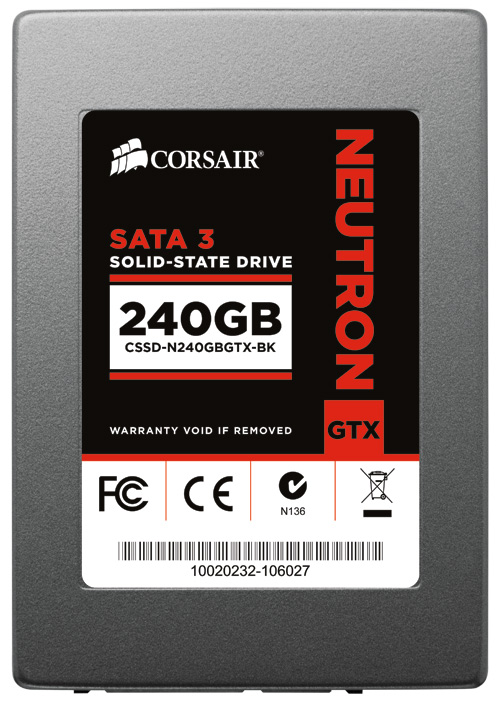
LAMD's powerful LM87800 controller ensures competitiveness of the Neutron GTX Series, but let’s not forget about the rest of the spec.
The principle difference between the Neutron and Neutron GTX is that GTX uses Toggle NAND rather than ONFI Sync NAND, and therefore offers both a high random read and write throughput, as well as high sequential write throughput. Neutron GTX also supports Adaptive DSP technology to help increase NAND endurance.
Neutron GTX features the traditional 2.5-inch form factor, but measures just 7mm in height and it is weighs only 47g, making it perfect for slim notebooks.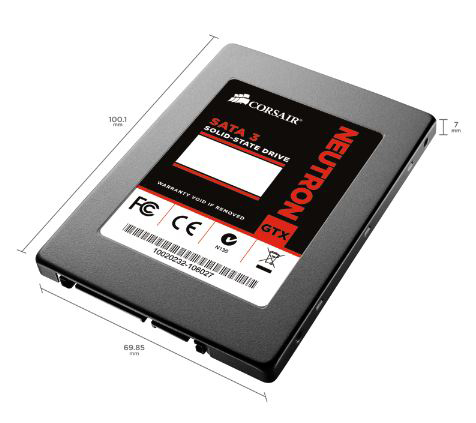
We like the small format of packaging too. You will get 3.5-inch adapter for use in standard PC cases.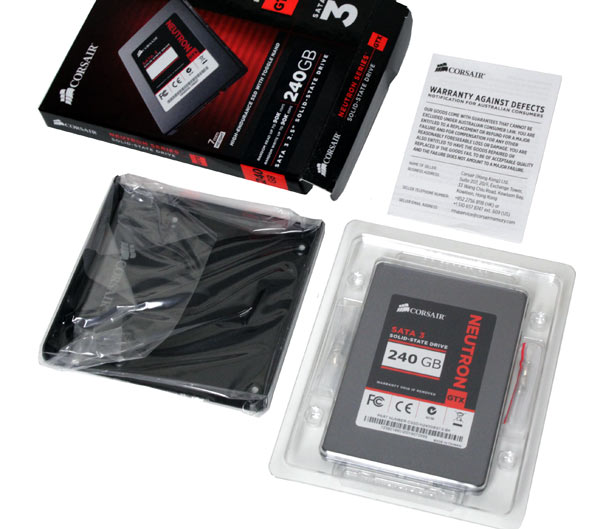
Specifications:
- SSD Controller: Link_A_Media Devices (LAMD) LM87800 6Gb/s SSD Controller
- Flash memory: Toshiba Toggle-mode NAND
- Interface: SATA III 6.0 Gb/s
- Capacities/Models: 120GB: CSSD-N120GBGTX-BK
240GB: CSSD-N240GBGTX-BK
480GB: CSSD-N480GBGTX-BK
- Operating Temperature: 0°C to +70°C
- Storage Temperature: -20°C to +85°C
- Operating Humidity: 10% to 90% RH (0° to +40° C)
- Storage Humidity: 5% to 90% RH (-10° to +60° C)
- Max Operating Altitude: 3,048 m (up to 10,000 ft.)
- Max Non-Operative Altitude: 12,192 m (up to 40,000 ft.)
- MTBF: 2,000,000 hours
Before we jump to the results, let’s take a look at what Corsair has to say about the Neutron Series and Neutron Series GTX SSD:
Designed for Multi-tasking - extremely high read/write IOPS This makes it ideal for complex data-intensive work that involves accessing multiple files simultaneously — video production, large-scale graphics editing, or running multiple office applications at once.
Rapid Sequential Read and Write Throughput – regardless of whether the data is compressed or not This is with any type of data, regardless of whether the data is compressible or incompressible. This gives Neutron GTX a significant advantage over SSDs that use on-the-fly compression, and therefore take a huge performance hit when writing compressed/incompressible files, such as encoded videos, compressed audio, and file archives.
Reliable and durable – for consistent performance over time All Neutron Series models incorporate LAMD's powerful eBoost™ on-the-fly error correction and advanced NAND management technologies. This improves the endurance of onboard flash memory, enhancing reliability and durability. The Neutron Series GTX drives also include adaptive DSP technology which maintains superior performance throughout the lifetime of the SSD.
Strong ECC
Strong ECC provides endurance benefits by allowing user data to be recovered under a greater variety conditions
Advanced NAND Management
Advanced NAND Management incorporates wear-leveling, garbage collection and defect management. This includes background media scans to ensure that there is sufficient margin in each NAND block to provide continued reliable operation of the drive.
Adaptive DSP (GTX only)
The A-DSP algorithm determines the optimum read threshold of the NAND with a minimum number of NAND reads. This provides not only enhanced endurance, but also helps to ensure consistent performance of the SSD even at end of life.
Microsoft® Windows® 7 TRIM support
All Neutron Series GTX drives also support the Windows TRIM command, which allows them to store only the data they need and perform NAND optimization to ensure the fastest possible write speeds.
We used EVGA’s X79 FTW motherboard in this review. However, the board is only a temporary solution, as we are putting together a Z77-based test rig. We will update our results soon and hopefully we will add a few other high-end SSDs to the mix.
Motherboard: EVGA X79 FTW
CPU: Sandy Bridge-E Core i7 3820 (3.6GHz)
CPU Cooler: Thermalright HR-02 (Thermalright-Europa Distri www.PC-Cooling.de).
Memory: 8GB ADATA DDR3 1600 XPG Gaming series
System drive: OCZ Vertex 2 100 GB
Power Supply: CoolerMaster Silent Pro 1000W
Case: CoolerMaster Cosmos II Ultra Tower
Operating System: Win7 64-bit
Graphics Card: GTX 670
Nvidia 310.70-desktop-win7-winvista-64bit-english-whql
Intel RSTe driver (iaStorA 11.7.0.1013)
Compressible data is data that shrinks in size when lossless compression is applied, opposite to incompressible data which does not does not shrink or grow in size when compression is applied.
The LAMD LM87800 6Gb/s SSD controller handles compressible data very efficiently, and the ATTO test illustrates its best case behavior nicely. On the next page we will see that performance does not drop much even when it comes to dealing with incompressible information.
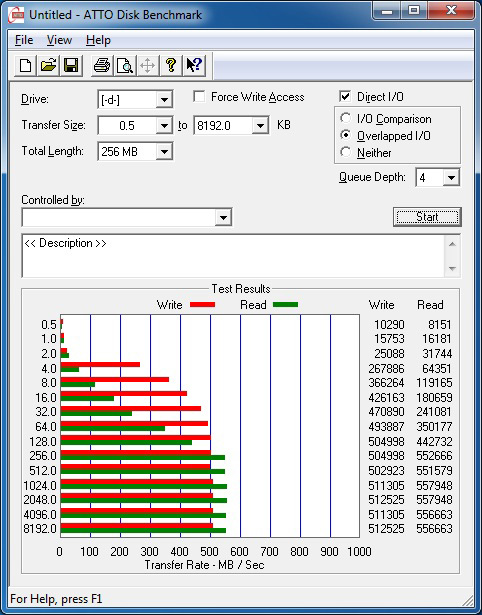
The read speed of Neutron GTX 240GB is impressive, topping out at nearly 557MB/s, while write speed is very close, with nearly 503MB/s.
The AS-SSD sequential benchmark, which uses incompressible data for all of its transfers illustrates performance nicely. Controllers that use on-the-fly compression for example will show big drop in sequential write speed when handling incompressible data.
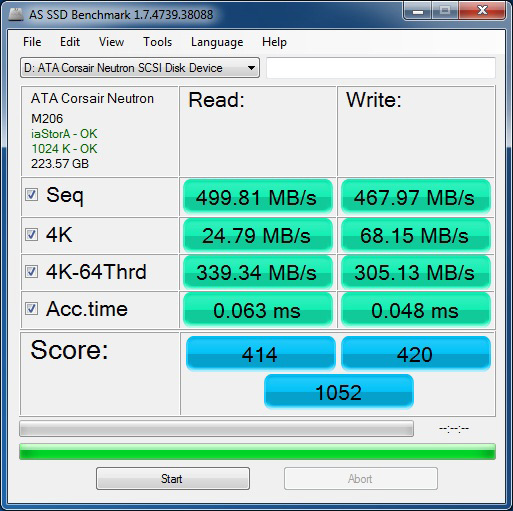
The overall score of AS SSD benchmark is really good, and it indicates that the Neutron GTX 240GB drive is a good performer.
CrystalDiskMark 3.0.2 shows really good performance when dealing with higher queue depths.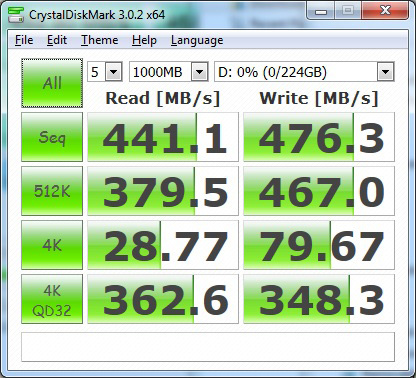
Here is what PCMark7 and Anvil's Data Storage Utility have to say about Neutron GTX 240GB.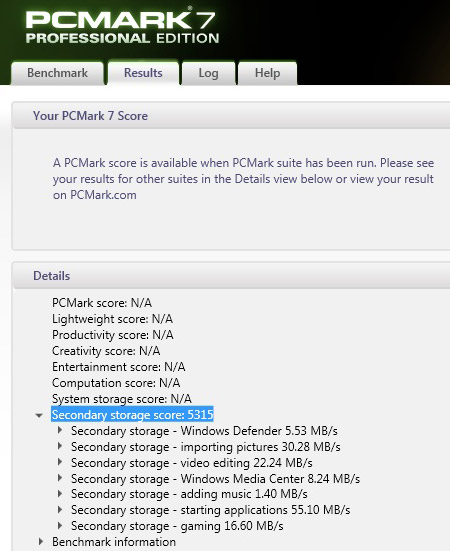
Anvil’s Storage utilities simulates a real usage scenario by using real test data.

New Corsair’s Neutron GTX series SSDs use the new LAMD's LM87800 controller and as our benches prove, the drives have a lot to offer.
This is the first LAMD LM87800-based drive we had a chance to test and we are happy to report that we could not identify any issues. The Neutron GTX 240GB ends up with fast access times and very good performance in all scenarios, with compressible or incompressible data, in random or sequential mode.
Of course, reliability is a very important aspect of any storage device, but we had the drive for a couple of days so we will update this preview later on, as soon as we get our new test rig up and running, and complete a series of more extensive tests.
So far so good, we are impressed. The asking price in Europe is €213, which is about €25 more than an OCZ Vertex 4 drive. The performance offered by the Neutron GTX probably justifies the premium and we hope to put the two drives head to head soon, so stay tuned.



